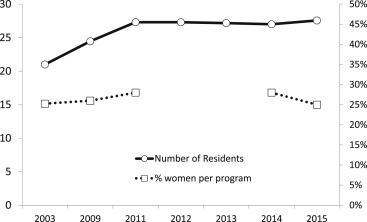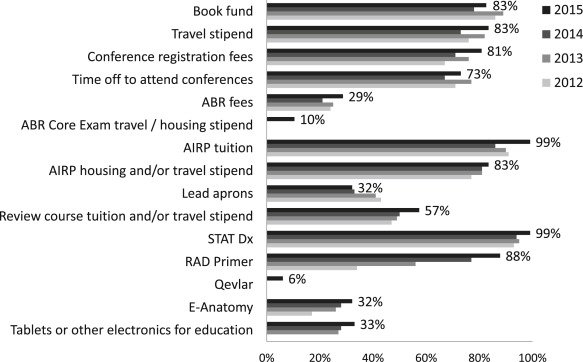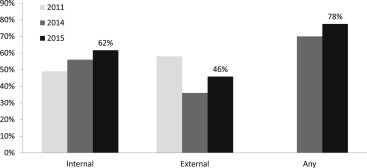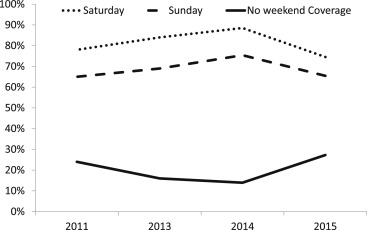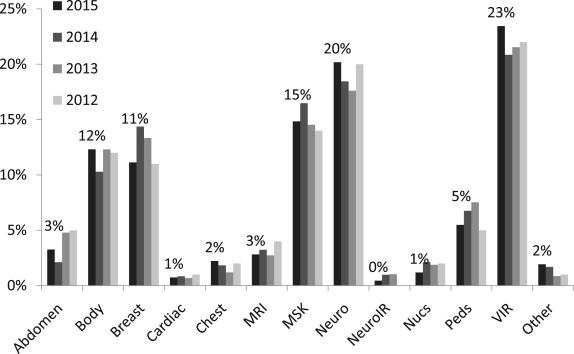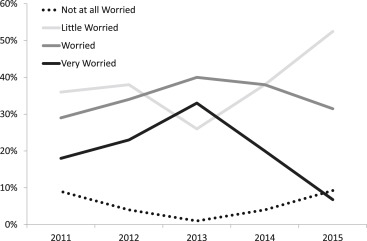Rationale and Objectives
The American Alliance of Academic Chief Residents in Radiology conducts an annual survey of chief residents in Diagnostic Radiology programs in North America. The survey serves as a resource for observing trends and disseminating ideas among radiology training programs.
Materials and Methods
An online survey was distributed to chief residents at 181 residency programs, with questions on a broad range of topics including resident benefits, program and call structure, American Board of Radiology Core exam preparation, fellowships, and the job market.
Results
A total of 193 individual responses were received from 120 programs, for a response rate of 66%. The responses were compared to data from prior years’ surveys, principally from 2012 to 2014.
Conclusions
Programs are shifting resident benefits spending toward Core exam preparation resources and away from lead aprons. In addition, 24-hour attending coverage continues to spread among programs, and the fraction of programs providing face-to-face postcall readouts continues to decline. Finally, although resident perception of the job market is now improving, residents feel that the job market continues to discourage medical students from entering radiology, a fact borne out by the 2015 match results. How the upcoming change to a direct interventional radiology residency will affect medical student interest is as yet uncertain.
The American Alliance of Academic Chief Residents in Radiology (A 3 CR 2 ) is an organization composed of chief residents at North American Diagnostic Radiology residency training programs with the purpose of developing leadership skills in chief residents and fostering collaboration and idea dissemination among its members . Each year, as part of its mission, the A 3 CR 2 conducts a survey of its members regarding a broad range of topics including resident benefits, program and call structure, American Board of Radiology (ABR) Core preparation, fellowships, and the job market. The results of this survey are presented at the Association of University Radiologists (AUR) annual meeting and are also made available on the A 3 CR 2 Web site. The survey has been administered since 1971, with maintenance of survey data at the Mallinckrodt Institute of Radiology .
Many chief residents and residency program directors and chairs of academic departments use the information from the survey to compare their programs to peer institutions and potentially guide program policies and budgetary decisions. Survey questions are formulated by chief residents at the Mallinckrodt Institute of Radiology using input from faculty advisors involved in the A 3 CR 2 and chief resident members of the A 3 CR 2 Steering Committee. The questions are updated each year based on findings in previous years’ data and emerging trends in the world of academic radiology and radiology training programs.
Materials and methods
Survey
Get Radiology Tree app to read full this article<
Participants
Get Radiology Tree app to read full this article<
Analysis
Get Radiology Tree app to read full this article<
Get Radiology Tree app to read full this article<
Results
Programs
Get Radiology Tree app to read full this article<
Get Radiology Tree app to read full this article<
Get Radiology Tree app to read full this article<
Get Radiology Tree app to read full this article<
Get Radiology Tree app to read full this article<
Resident Benefits
Get Radiology Tree app to read full this article<
Get Radiology Tree app to read full this article<
Get Radiology Tree app to read full this article<
Get Radiology Tree app to read full this article<
Get Radiology Tree app to read full this article<
Get Radiology Tree app to read full this article<
Chief Residents
Get Radiology Tree app to read full this article<
Get Radiology Tree app to read full this article<
After-Hour Coverage and Call Responsibilities
Get Radiology Tree app to read full this article<
Get Radiology Tree app to read full this article<
Get Radiology Tree app to read full this article<
Get Radiology Tree app to read full this article<
Get Radiology Tree app to read full this article<
Get Radiology Tree app to read full this article<
Get Radiology Tree app to read full this article<
Get Radiology Tree app to read full this article<
Get Radiology Tree app to read full this article<
The Core Exam
Get Radiology Tree app to read full this article<
Get Radiology Tree app to read full this article<
Get Radiology Tree app to read full this article<
Get Radiology Tree app to read full this article<
Table 1
Logistic Regression Model for ABR Core Examination Pass Rates
Variable Odds Ratio (95% CI)P Value Number of residents in program 1.09 (1.02–1.17) .015 24-Hour attending coverage 0.35 (0.08–1.44) .145 Program pays for external board review 1.43 (0.41–5.00) .580 Program provides a block of time away from clinical service (wk) 0.15 (0.03–0.62) .009 Program provides a period of time per day off clinical service 1.40 (0.35–5.56) .637
ABR, American Board of Radiology; CI, confidence interval.
Predictors of programs with a Core exam pass rate >75% (as compared to ≤75%), analyzed using a multivariate logistic regression model. A total of 101 programs were included in this analysis, with 17 of 101 cases having a pass rate ≤75%. Odds ratios greater than 1.0 imply a higher chance for that program to have a pass rate >75%.
Get Radiology Tree app to read full this article<
Get Radiology Tree app to read full this article<
Table 2
Popular Core Exam Review Resources
Resource Number of Programs (%) RSNA/AAPM physics modules 100 (94) RadPrimer 100 (94) External review course on physics topics (eg, Huda) 86 (81) Radiology review books not directed toward the Core exam (eg, RadCases, case review series) 82 (77) Radiology physics review books (eg, Huda) 74 (70) External review course on radiology topics (eg, Duke) 67 (63) ABR quality and safety document 63 (59) Radiology review books specifically directed toward the Core exam 51 (48) Radiographics articles 49 (46) RAPHEX exams 45 (42) Review course on DVD 31 (29) Question Bank other than RadPrimer (eg, Qevlar) 26 (25)
ABR, American Board of Radiology; AAPM, American Association of Physicists in Medicine; RSNA, Radiologic Society of North America.
Popularity of various Core exam review resources, of 106 programs responding to the question.
Get Radiology Tree app to read full this article<
Fellowships
Get Radiology Tree app to read full this article<
Get Radiology Tree app to read full this article<
Get Radiology Tree app to read full this article<
Job Market
Get Radiology Tree app to read full this article<
Get Radiology Tree app to read full this article<
Resident Feedback and Milestones
Get Radiology Tree app to read full this article<
Get Radiology Tree app to read full this article<
Get Radiology Tree app to read full this article<
Discussion
Get Radiology Tree app to read full this article<
Resident Benefits
Get Radiology Tree app to read full this article<
After-Hour Coverage
Get Radiology Tree app to read full this article<
Get Radiology Tree app to read full this article<
Core Exam
Get Radiology Tree app to read full this article<
Get Radiology Tree app to read full this article<
Fellowships
Get Radiology Tree app to read full this article<
Job Market
Get Radiology Tree app to read full this article<
Get Radiology Tree app to read full this article<
Get Radiology Tree app to read full this article<
Get Radiology Tree app to read full this article<
Acknowledgments
Get Radiology Tree app to read full this article<
Supplementary data
Get Radiology Tree app to read full this article<
Supplementary Materials
Get Radiology Tree app to read full this article<
References
1. AUR Online - About A3CR2. Available at: https://www.aur.org/Secondary-Alliances.aspx?id=487 . Accessed May 4, 2015.
2. Lawler L.P., Fromke J., Jost R.G., et. al.: Results of and comments on the 2000 Survey of the American Association of Academic Chief Residents in Radiology. Acad Radiol 2001; 8: pp. 777-781.
3. Sauk S., Jokerst C., Gould J., et. al.: Results of the 2012 survey of the American Association of Academic Chief Residents in Radiology. Acad Radiol 2013; 20: pp. 320-331.
4. Shetty A., Hammer M., Gould J., et. al.: Results of the 2014 Survey of the American Alliance of Academic Chief Residents in Radiology. Acad Radiol 2014; 21: pp. 1331-1347.
5. Evens R.G.: Report on a survey of chief residents in Academic Departments of radiology. Invest Radiol 1972; 7: pp. 61-62.
6. Peterson C.M., Gerstle R., Bhalla S., et. al.: Results of the 2004 survey of the American Association of Academic Chief Residents in Radiology. Acad Radiol 2005; 12: pp. 373-378.
7. Geography UCB 2010 Geographic Terms and Concepts - Census Divisions and Census Regions. Available at: https://www.census.gov/geo/reference/gtc/gtc_census_divreg.html . Accessed May 4, 2015.
8. Lautenberger D.M., Dandar V.M., Raezer C.L., et. al.: The State of women in academic medicine: the pipeline and pathways to leadership, 2013-2014.2014.AAMCWashington, D.C
9. McNeeley M.F., Prabhu S.J., Monroe E.J., et. al.: The nature and scope of moonlighting by radiology trainees. Acad Radiol 2013; 20: pp. 249-254.
10. Philibert I., Friedmann P., Williams W.T., for the members of the ACGME Work Group on Resident Duty Hours: New requirements for resident duty hours. JAMA 2002; 288: pp. 1112-1114.
11. The American Board of Radiology IC DR Exam Scoring and Results | The American Board of Radiology. Available at: http://www.theabr.org/ic-dr-score . Accessed May 6, 2015.
12. Lionhart P.: Crack the Core Exam - Volume 1: Strategy guide and comprehensive study manual.2nd ed.2014.CreateSpace Independent Publishing PlatformCharleston, SC
13. Holmboe ES, Edgar L, Hamstra S. ACGME > Program and Institutional Accreditation > Next Accreditation System > Milestones. Available at: https://www.acgme.org/acgmeweb/tabid/430/ProgramandInstitutionalAccreditation/NextAccreditationSystem/Milestones.aspx . Accessed May 12, 2015.
14. Collins J., Gruppen L.D., Bailey J.E., et. al.: 24/7/365 in-house radiologist coverage: effect on resident education. Acad Radiol 2014; 21: pp. 842-850.
15. Review Committee for Diagnostic Radiology: Frequently asked questions: diagnostic radiology.2014. Available at: https://www.acgme.org/acgmeweb/portals/0/pdfs/faq/420_diagnostic_radiology_faqs.pdf . Accessed May 12, 2015
16. DeStigter K.K., Mainiero M.B., Janower M.L., et. al.: Resident clinical duties while preparing for the ABR core examination: position statement of the Association of Program Directors in Radiology. J Am Coll Radiol 2012; 9: pp. 832-834.
17. NRMP: Results and data: Specialties matching service, 2015 appointment year.2015. Available at: http://www.nrmp.org/wp-content/uploads/2015/02/Results-and-Data-SMS-2015.pdf . Accessed May 12, 2015
18. Bluth E.I., Truong H., Bansal S.: The 2014 ACR Commission on Human Resources workforce survey. J Am Coll Radiol 2014; 11: pp. 948-952.
19. NRMP: Advanced data tables: 2015 main residency match.2015. Available at: http://www.nrmp.org/wp-content/uploads/2015/03/ADT2015_final.pdf . Accessed May 12, 2015
20. Roubidoux M.A., Packer M.M., Applegate K.E., et. al.: Female medical students’ interest in radiology careers. J Am Coll Radiol 2009; 6: pp. 246-253.
21. Zener R, Visscher K, Lee S, et al. Why are fewer women selecting a career in radiology? 2013, Poster presented at European Congress of Radiology. Available at: http://dx.doi.org/10.1594/ecr2013/C-1127 . Accessed May 12, 2015.
